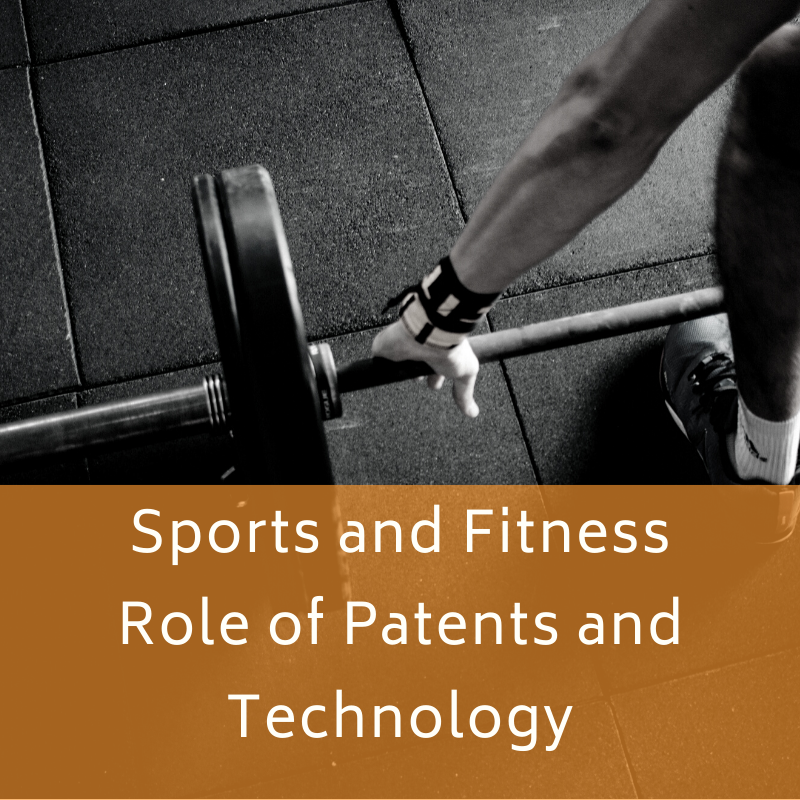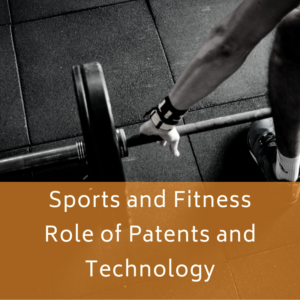
Technology innovations in sports and fitness are protected by patent rights. Patent law system enables patent owners to prevent copycats from entering the market. Sporting companies establish market authority by way of branding efforts protected by registered trademarks.
Patents play a crucial role in sports, wherein protection under patent law can be sought for training equipments, golf clubs, stop-watches, nutritional supplements, sporting goods, and the like. Latest examples of sports patents also include sport drinks and muscle enhancers.

Inventions in sports can change the dynamics of the entire ecosystem. Multiple innovations in sports have proven to be a fuel for growing intangible assets, which can be protected by various intellectual property rights, including patents, trademarks, copyrights and designs.
Rapid market growth in fitness industry has led to portfolio of fitness patents that contribute to innovative fitness solutions. Data related to health and fitness can be processed to reveal interesting insights. Data analytics tools are protected under the patent system to bring innovative products to the markets across the world.
Similar to other businesses, various aspects of sporting world provide competitive edge to owners of intellectual property rights (IPR). Sports business owners connect with their fans by tapping the benefits of the intangible assets associated with IPR in sports. A common strategy to excel in sports business is to file sports technology patents that increase the revenue goals for the shareholders.
A microscopic view of sports industry reveals that the sports business includes tangible as well as intangible assets. The intangible assets cover items that are eligible for sports utility patents. Companies leverage the intellectual property rights in sports for business advantage to excel multifold.
Patent searches conducted across US Patent Office reveals that companies file patents for prediction inventions (betting, gambling) in sports. Examples of sports prediction patents include predicting occurrence that happen during a live sports event, predicting outcome of sporting events, and the like.
Worldwide patent trends illustrate that multiple patents are filed regularly for equipments. Sports equipment patents include various types, such as, for example, training equipments, gym equipments, safety bicycles, boards, exercise platforms etc.
Electronic Arts has a dedicated sports divisions named EA Sports that is involved in creating and publishing sports games. Gillette recently announced that it will sponsor the EA SPORTS FIFA 20 Global Series, which is a nine month long competitive gaming ecosystem of tournaments.
Sports game development and publication requires constant innovation and patent search results show that EA Sports Patents cover a diverse range of innovations, like, altering perception of virtual content, computer architecture for animation of a character, generating digital elements, fraud detection techniques, machine learning based anomaly detection, etc.
There have been various examples of sports patents that have caused a high degree of impact. Examples of famous sport patents include drone patents, 3D printer, bionic eye, GPS or global positioning system, gene editing, brain implants, Bluetooth etc.
Sports goods and fitness industry regularly face legal challenges and patent attorney provides counselling to clients for IP protection by way of patent filing, patent drafting, patent analytics, patent infringement opinions, patent claim charts and patent licensing transactions. Sports attorneys gain significant experience in sports laws, sports leagues rules, player rights, IP ownership rights and brand protection strategies.
Commercial rights associated with a famous person’s name or brand fall under the category of personal rights. Sports players and athletes have personality rights that are commercially exploited to generate revenues for the players. While considering branding and image rights of sportspersons, legal protection helps the players by way of trademarks, copyrights and designs.
The world intellectual property organization, or WIPO has stressed repeatedly on the economic importance of sports across the global scenario. Sports related inventions are protected across multiple jurisdictions by taking advantage of the Patent Cooperation Treaty, or the PCT, wherein a single application can be filed across 100+ countries in a total allowed duration of 30 or 31 months from the earliest priority date.
The sports, fitness, and well-being sectors can be enhanced by monitoring the physiological conditions of wearers. Optimizing behavior during training and competition is desirable for athletes to achieve high performance. Providing information in real-time for athletes and trainers to observe and make adjustments during training and competition is desirable.
Protection, a particular issue in impact sports such as football, ice hockey, and boxing, can be enhanced with wearable technologies. Helmets can be functionalized with sensing capabilities to monitor head movement during collision events in games (with equipment, other players, or the ground).
More informative data than simulations improves the ability to produce suitable protection. For example, Everlast® boxing headgear instrumented with 12 single-axis linear accelerometers has been successfully validated to provide information about the severity and location of impacts (Beckwith et al., 2007). The general health of consumers can be monitored with wearable technology to provide information about well-being, desirable with greater awareness of an individual’s health. Wrist-worn activity trackers are the most frequently used device in this category due to convenience and unobtrusiveness appearing similar to a watch.
Devices include wrist bands, armbands, and incorporation in sports clothing. Wrist-worn devices seem most common. Accuracy, precision, and health benefits of wrist activity trackers have been investigated. Wrist-worn devices (Apple® watch, Samsung® Gear Fit, Samsung® Gear 1, 2, S, iHealth® Tracker (AM3), Pebble® Steel, Pebble® Watch, Qualcomm® ToqTM, Motorola® Moto 360, Garmin® Vivofit, XiaomiTM MI Band, MisfitTM Shine, Jawbone® Up, Nike®+Fuelband SE, Sony® Smartwatch (SWR10), Fitbit® Flex) have been compared for monitoring steps and heart rate (El-Amrawy and Nounou, 2015). Misfit® Shine was reported to have the highest data accuracy (99.1%) and Samsung® Gear 2 the lowest (79.8%), while data precision was lowest for Misfit Shine and Qualcomm Toq (4%) and highest for Jawbone Up (17.5%) (El-Amrawy and Nounou, 2015).
A study by Kaewkannate and Kim (2016) contradicted these results: WithingsTM Pulse was reported to have the highest accuracy for measuring step and distance followed by Fitbit® Flex, Jawbone® Up24, and Misfit® Shine (Kaewkannate and Kim, 2016). In both studies, the accuracy of steps recorded by a number of devices was compared but different conclusions were reached (i.e. MisfitTM Shine reported with highest and lowest accuracy, respectively, of the devices tested).
Different methods could account for observed differences. El-Amrawy et al (2015) examined user satisfaction, opinions, and reviews, compared to a wear trial conducted by Kaewkannate and Kim (2016). In addition, wearing multiple devices at one time means the position of the devices differs slightly, possibly altering effectiveness. Fitness trackers are often designed to be worn at the wrist, but some were worn near the elbow in trials by Kaewkannate and Kim (2016).
The specific Misfit® Shine device or edition of the device may also have varied in each study, contributing to observed differences. Investigations on wearable devices performing similar functions differed in findings, these differences attributable to a number of factors: different operating systems (algorithms, interfaces), sensors, and accuracy has been reported to vary according to user differences (e.g. weight, sex, age, height) (El-Amrawy and Nounou, 2015). Therefore, the device and user can influence accuracy.
Armbands for monitoring physiological parameters in sports, fitness, and well-being have been developed. The SenseWear Pro ArmbandTM was designed to estimate the energy expenditure of the wearer during exercise. Several studies have been undertaken to determine the accuracy of devices (Jakicic et al., 2004; Arvidsson et al., 2007; Dwyer et al., 2009). Each study concurred, reporting underestimation of energy expenditure measured using the armband, thus highlighting the need for further refinement.
Textile-based products with sensing capabilities are available for sports, fitness, and well-being. StretchsenseTM (New Zealand) and Danfoos PolypowerTM (Denmark) have produced stretch sensors to monitor muscle activity and volume changes which can be integrated into apparel items (Dalsgaard and Sterrett, 2014). Heart rate sensors have been integrated into sports bras and t-shirts (Adidas®, miCoachTM range subsequently merged with Runtastic®, Sensoria® fitness range) (Dalsgaard and Sterrett, 2014).
Incorporating a device in clothing further enhances wearables for sports and fitness because clothing is already worn and will add little extra weight, or air resistance (a particularly important issue for elite athletes). The market size of the sports and fitness tech has been calculated. A compound annual growth rate of 38% and 25% (2016-2020) was predicted for wearable sports and fitness devices, respectively (Technavio, 2016).
Wrist-worn devices are still a large part of the sector. Fitbit® dominated the sector, holding 67% of sales in the United States in 2013 (Wu et al., 2016). However, Apple® has been reported to be the leading company in smart wrist band production as of 2017 (Kharpal, 2017).
The sports and fitness sector is likely to grow and diversify. For example, smart shoes (e.g. soccer boots), are expected to reach numbers of around five million pairs by 2020 according to CCS Insight (Gonzalez, 2017). The well-being sector can be estimated through smartwatches with enhanced functionalities for health monitoring (e.g. steps, heart rate). For example, global smartwatch sales are estimated to reach 141 million units in 2018, holding 50% of total sales in global wearable technology (Statista, 2017). This could be due to the desirable stylish appearance of smartwatches, multi-functionality of health monitoring, and other technological functions (e.g. social media, phone calls).
A strong patent protection results from multiple patent applications that claim various inventive aspects. In use, the same basic components can be tailored to specific applications (e.g. health care; sport, fitness, and well-being; workplace; fashion). Wearable technology has a long history with rapid expansion since the beginning of the 21st century, which is expected to continue. Trials comparing the performance of existing and new wearable devices to more traditional, evidence-based data collection procedures are critical. Long-term trials to determine the end-life of devices are also required, focusing on the degradation of accuracy and reliability over time. Interesting and useful wearable technology devices, textiles, and garments have been developed, but the gap between laboratory and real-life applications remains.
Advocate Rahul Dev is a Patent Attorney & International Business Lawyer practicing Technology, Intellectual Property & Corporate Laws. He is reachable at rd (at) patentbusinesslawyer (dot) com & @rdpatentlawyer on Twitter.
Quoted in and contributed to 50+ national & international publications (Bloomberg, FirstPost, SwissInfo, Outlook Money, Yahoo News, Times of India, Economic Times, Business Standard, Quartz, Global Legal Post, International Bar Association, LawAsia, BioSpectrum Asia, Digital News Asia, e27, Leaders Speak, Entrepreneur India, VCCircle, AutoTech).
Regularly invited to speak at international & national platforms (conferences, TV channels, seminars, corporate trainings, government workshops) on technology, patents, business strategy, legal developments, leadership & management.